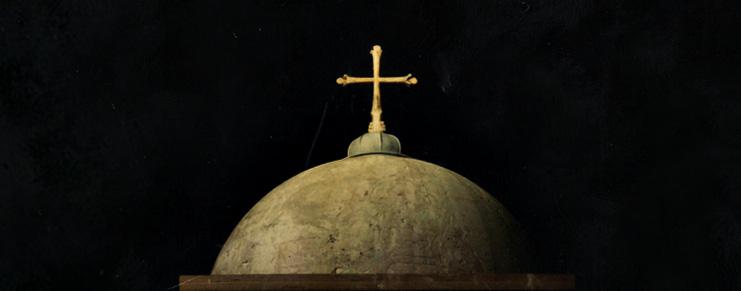

Symbol of the efforts of unity
Easter in 1996 at the Dome of the Resurrection the Greek Patriarch Diodoros I of Jerusalem consecrated the new, monumental Cross of Golgotha that since then marks the place where Jesus is said to have been crucified.
All happened at the initiative of Prof. Gustav Kühnel, the professor of art history at the university of Tel Aviv and the internationally renowned and proven expert for Byzantian art history in the Holy Land.
Based on his iconographic concept, the artistic design was conceived by my mentor, the German sculptor Paul Nagel of Cologne. Working together with Johannes Nagel, one of Paul Nagel’s sons, I then brought it all into being.
Both Gustav Kühnel and Paul Nagel have since sadly passed over.
As a young man who had just branched out on my own, and without knowing much about the sumptuary laws in religious and ecclesio-political matters - which consequently led to difficulties and even hostilities - I simply got this project off the ground, as it were, and it was given to make it all happen.
It was an extraordinarily inspiring time and an instructive experience for me.
The wee hours of the morning in Jerusalem
The most intensive memories I have are of the wee hours of the morning in Jerusalem!
Whenever around 4 in the early morning my team and I made our way through the Old City and up to the dome of the so called Catholicon we watched the sun as it rose over the rooftops of Jerusalem to awaken a sleeping city and its people.
With the first clouds of frankincense emerging from the Church of the Holy Sepulcher, tickling our noses and the muezzin calling to us from the Dome of the Rock, we watched the believers of different religions on their way to their respective holy sites to pray and start the new day.
It might just be that Jerusalem is much more the epitome of the possibility of the peaceful co-existence of religions than what the latent hostilities and the budding violent clashes lead us to believe.
 I would love to have been able to travel to Jerusalem this past year to see how the cross has been holding up, to see if the lighting equipment is still working or if anything needs to be repaired.
I would love to have been able to travel to Jerusalem this past year to see how the cross has been holding up, to see if the lighting equipment is still working or if anything needs to be repaired.
This was not possible because of the Corona pandemic.
Fortunately, just yesterday I found out that the cross by the end of 2020 got a new lighting - likely for its 25th anniversary. And current pictures send by Jerusalem friends yesterday confirmed it.
Unfortunately, the originally backlit inner cross, made of aragonite and rock crystals, was sacrificed to LED-panels - but for sure with the greatest luminosity.
Unfortunately, the meaning and symbolic power of the gems of the inner cross were not respected or known: The center cross inside the cross representing the risen Christ, surrounded by his twelve apostles.
The original iconographic concept originated from work Gustav Kühnel did with Prof. George Lavas of Athens, referring to the memorial cross that can be reasonably assumed by having been surmounted the actual rock of Golgotha in the Early Byzantine period, the “Crux Gemmata”.
It was Gustav Kühnel’s intention to model the appearance on art-historical patterns dating from the period prior to the schism. He wanted it to be seen as an exemplary symbol of the efforts of unity in the community of Christian faith.
The new crucifix should not only be worthy of the singularity of the site.
Crux Gemmata


Unfortunately, the memorial Cross of Golgotha today is no longer the “Crux Gemmata” anymore - but a neon sign.
It makes no difference at all whether this was allowed to happen due to a lack of knowledge or interest, due to ignorance or arrogance: It is just a shame!
Like no other building the church of the Holy Sepulcher in Jerusalem draws together history, the present and the future in the way Christian communities evolve and coexist.
Like no other place, Jerusalem draws together history, the present and the future in the way Abrahamic faiths evolve and coexist.
Unlikely, if you look at it like this, the memorial Cross of Golgotha at the Church of the Holy Sepulcher right now became just another sign of power and possession, of having and wanting.
And not of being and receiving, of suffer and salvation: But I do hope not.
Reconciliation and peaceful coexistence as brothers and sisters in the one world is what Gustav Kühnel wanted the Cross of Golgotha to stand for. I know this from the conversations I had with my late friend.
In 1996 I was much too naïve to be able to reflect on all he had told me.
But looking back today, I say that it must have been just this utter naïveté that brought the cross at the Church of the Holy Sepulcher to even come into being in the year 1996, 25 years ago.
Good Friday 2021, Michael Hammers

















